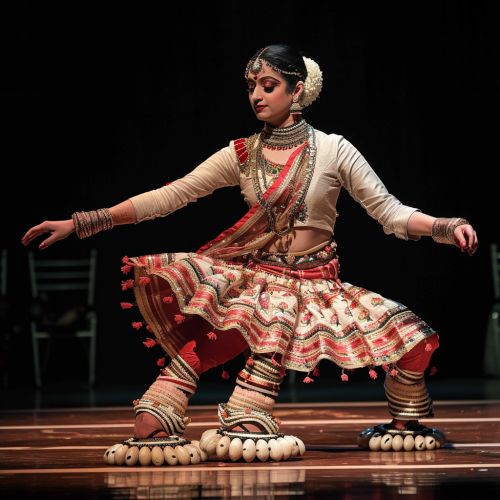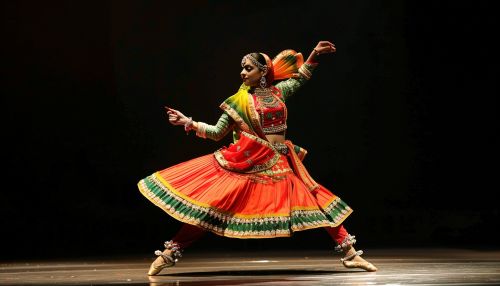Kathak
Introduction
Kathak is one of the eight major forms of Indian classical dance. Originating from the northern regions of India, Kathak is characterized by intricate footwork, spins, and expressive gestures and facial expressions. The term "Kathak" is derived from the Sanskrit word "Katha," meaning "story," and "Kathakar," meaning "the one who tells a story." Historically, Kathak dancers, known as Kathakars, were storytellers who conveyed mythological and moral tales through dance, music, and mime.
Historical Background
Ancient Origins
Kathak has its roots in the ancient temples of northern India, where it was performed as a form of devotional worship. The earliest references to Kathak can be found in the texts of the Natya Shastra, an ancient Indian treatise on performing arts attributed to the sage Bharata Muni. The dance form evolved over centuries, incorporating elements from various cultural influences, including Persian and Mughal traditions.
Mughal Influence
The Mughal era marked a significant transformation in Kathak. The dance form moved from the temples to the courts of the Mughal emperors, where it underwent a stylistic evolution. The Mughal influence introduced elements of Persian dance, music, and aesthetics, leading to the development of the Lucknow and Jaipur gharanas (schools) of Kathak. The Lucknow gharana is known for its emphasis on expressiveness and grace, while the Jaipur gharana is renowned for its vigorous footwork and spins.
Technique and Style
Footwork (Tatkar)
One of the most distinctive features of Kathak is its intricate footwork, known as Tatkar. Dancers wear ghungroos (ankle bells) to accentuate the rhythmic patterns produced by their feet. The complexity of the footwork varies, ranging from simple patterns to highly intricate sequences that require exceptional skill and precision.
Spins (Chakkars)
Spins, or Chakkars, are another hallmark of Kathak. Dancers execute rapid, controlled spins that are often synchronized with the rhythm of the accompanying music. The ability to perform multiple spins in quick succession is a testament to a dancer's technical prowess and balance.
Gestures and Expressions (Mudras and Abhinaya)
Kathak employs a rich vocabulary of hand gestures (Mudras) and facial expressions (Abhinaya) to convey emotions and tell stories. These elements are integral to the narrative aspect of Kathak, allowing dancers to depict characters and scenes from mythological tales and classical literature.


Musical Accompaniment
Kathak performances are typically accompanied by a variety of musical instruments, including the tabla (a pair of hand drums), harmonium, sarangi (a bowed string instrument), and sitar (a plucked string instrument). The interplay between the dancer and the musicians is a key aspect of Kathak, with the dancer often improvising to the rhythms and melodies provided by the musicians.
Repertoire
Nritta
Nritta refers to the pure dance aspect of Kathak, focusing on rhythm, footwork, and spins without any narrative content. It showcases the dancer's technical abilities and mastery of complex rhythmic patterns.
Nritya
Nritya combines elements of pure dance with expressive gestures and facial expressions to convey a story or theme. This aspect of Kathak emphasizes the dancer's ability to communicate emotions and narratives through movement.
Natya
Natya is the dramatic aspect of Kathak, involving the portrayal of characters and scenes from mythological and classical stories. It is a highly expressive form of dance that requires a deep understanding of the characters and narratives being depicted.
Gharanas (Schools)
Kathak has several distinct gharanas, each with its own unique style and repertoire. The most prominent gharanas are:
Lucknow Gharana
The Lucknow gharana is known for its emphasis on grace, expressiveness, and intricate gestures. It places a strong focus on Abhinaya (expressive dance) and the portrayal of delicate emotions.
Jaipur Gharana
The Jaipur gharana is renowned for its vigorous footwork, powerful spins, and dynamic movements. It emphasizes technical precision and the execution of complex rhythmic patterns.
Banaras Gharana
The Banaras gharana is a blend of the Lucknow and Jaipur styles, incorporating elements of both expressiveness and technical prowess. It is known for its distinctive use of the tabla and pakhawaj (a barrel-shaped drum) in its musical accompaniment.
Modern Developments
In the contemporary era, Kathak has continued to evolve, with dancers and choreographers experimenting with new themes, narratives, and musical compositions. While traditional Kathak remains a vital part of Indian cultural heritage, modern interpretations have expanded its reach and appeal to global audiences.
